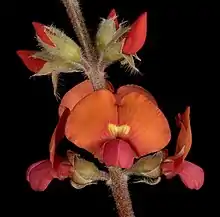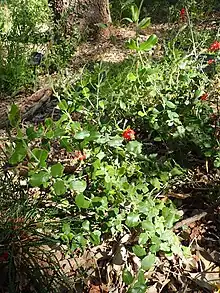| Gastrolobium villosum | |
|---|---|
 | |
| Scientific classification | |
| Kingdom: | Plantae |
| Clade: | Tracheophytes |
| Clade: | Angiosperms |
| Clade: | Eudicots |
| Clade: | Rosids |
| Order: | Fabales |
| Family: | Fabaceae |
| Subfamily: | Faboideae |
| Genus: | Gastrolobium |
| Species: | G. villosum |
| Binomial name | |
| Gastrolobium villosum | |
Gastrolobium villosum (common name crinkle-leaf poison[3] or crinkle-leaved poison)[4] is a low spreading shrub in the pea family (Fabaceae), native to Western Australia.[4] Like most Gastrolobiums it is poisonous to stock.[3]
It was first described by George Bentham in 1839.[1][2] There are no synonyms.[1][5]
It is deemed to be "Not Threatened" under Western Australian conservation law.[4]
Etymology
The specific epithet, villosum, is a Latin adjective, villosus, -a, -um ("villous") and describes the plant as having "long, soft, straight (not interwoven) hairs".[6]
References
- 1 2 3 "Gastrolobium rigidum". Australian Plant Name Index, IBIS database. Centre for Plant Biodiversity Research, Australian Government.
- 1 2 Lindley, J. (1839). A Sketch of the Vegetation of the Swan River Colony. pp. xiii.
- 1 2 Aplin, T.E.H. (1973). "Poison plants of Western Australia : the toxic species of the genus Gastrolobium and Oxylobium". Bulletin 3772. Department of Agriculture and Food, Western Australia, Perth.
- 1 2 3 "Gastrolobium villosum". FloraBase. Western Australian Government Department of Biodiversity, Conservation and Attractions.
- ↑ "Gastrolobium villosum Benth. | Plants of the World Online | Kew Science". Plants of the World Online. Retrieved 30 August 2020.
- ↑ Stearn, W.T. (2004). Botanical Latin (4 ed.). Oregon: Timber Press. p. 528. ISBN 9780881926279.
External links
This article is issued from Wikipedia. The text is licensed under Creative Commons - Attribution - Sharealike. Additional terms may apply for the media files.
